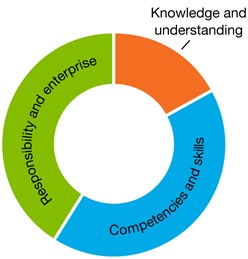Explore content
The Australian Curriculum in this year level supports the development of all dimensions of consumer and financial literacy as shown in the diagram below.

Approximate proportion of dimensions addressed in Year 5
Typically, at this level, students learn about the importance of planning for future needs and wants. They develop an understanding of why decisions need to be made when allocating resources, the various factors that may influence them when making decisions and the different methods that can be used. Students examine how societies allocate and sustainably manage limited resources, including through government services, laws and the application of scientific knowledge.
Students continue to build their knowledge, understandings and skills and are able to apply these to an increasing range of consumer and financial contexts. They explore the influences on their behaviour as consumers and use a range of methods to make informed consumer and financial choices. They comprehend informative and persuasive texts relating to consumer and financial matters, and analyse these texts to identify purpose, viewpoints and reliability, including identifying the key features used to influence consumer decision-making. Students use mental and written strategies and apply appropriate digital technologies to solve problems, and develop simple financial plans for immediate and future needs and wants. They analyse, manage, manipulate and present consumer and financial data in different formats. They apply enterprising behaviours to real-life contexts, building on their ability to collaborate, generate ideas, create goals and predict outcomes. When sharing ideas and communicating in online environments, students apply relevant social and ethical protocols. They make responsible financial and consumer decisions that take account of a range of factors such as values, ethical perspectives, sustainability and personal goals.
Moneysmart for teachers provides a number of interdisciplinary units and interactive activities that support the teaching and learning of consumer and financial literacy in this year level. Access a list of relevant resources that link to the Australian Curriculum using the right-hand menu.
Year 5 Never too young to be Moneysmart with clothes
Year 5 Hey! Let’s have a big day out!
Digital activity – Helping out
Digital activity – Calls, messaging and browsing
Digital activity – Choosing a mobile plan
Digital activity - Entertainment
Digital activity – Fun day out
Digital activity – MilbaDjunga – Smart Money – Primary Unit
Digital activity – Mobile credit

